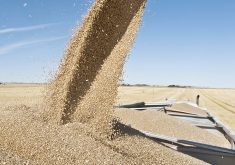Buyers are trying to bribe farmers to grow sunflowers, but most aren’t interested because of disease problems.
Farmers are walking away from sunflowers even with new crop confectionary sunflower prices at 35 to 36 cents per pound.
“We expect a 25 percent drop (in sunflower acres in Manitoba),” said buyer Mike Marion of Roy Legumex.
“There are other crops out there that look appealing, and we have to compete with that.”
Prices are not the main culprit because most crop calculators show sunflowers will likely be the most profitable crop in the Red River Valley this summer.
Read Also

Soybean market still figuring out implications of China-U.S. pact
Soybean futures had a muted reaction to the U.S. trade deal with China as the market tries to figure out the nuances of the deal.
The problem is that farmers don’t trust the crop to produce well after recent sclerotinia outbreaks.
“Disease has hit hard for the last two years,” said Darcelle Graham, executive director of the National Sunflower Association of Canada.
Sclerotinia wrecked the quality of many Manitoba crops in 2009 and 2010 and is likely present in many fields this year as well.
Farmers are reluctant to push their rotations too hard.
Agronomists recommend that they not grow sclerotinia-susceptible crops closely together in rotation. Canola and soybeans, which are popular crops in sunflower territory, also can carry sclerotinia.
The slump in acreage is also part of a larger phenomenon of farmers fleeing niche crops and concentrating on big crops such as canola, corn, soybeans and wheat.
The mainstream crops are easier to market and because prices for almost all crops are high, farmers are growing more of the bigger crops and fewer niche crops, Mike Krueger of the crop adviser firm Money Farm said at Manitoba Ag Days held Jan. 18-20 in Brandon.
Graham said the 20 to 30 percent drop in sunflower acres predicted for this year will hit her organization’s funding base.
“We might have to ride it out for a couple of years,” she said.
“We’ve put money aside for a rainy day and we might have to start using it.”
Old crop prices are still strong, at 30 cents per lb. for rounds and 31 cents for longs, said Marion.
Graham said the much higher new crop prices are a sign that buyers are trying to buy acreage for 2011.
Marion said while old crop prices have remained firm, product from Argentina is beginning to hurt demand for North American grown sunflower.
“We’re feeling it in the sales,” he said.
Buyers are attracted to Argentina’s high quality crop because they have been dealing with many damaged North American crops.
Graham said her organization believes in the future of confectionary sunflowers and won’t be rattled by a brief decline in acres.
She said good fortune probably awaits for those who stick with the crop this summer and have good weather.
“If acres are going to be down, prices are going to have to be (up) there,” she said.
“If guys can produce a crop that has quality, they’re looking good.”















